#Roof Coatings Canberra
Explore tagged Tumblr posts
Text
Top 5 Benefits of Roof Restoration in the Canberra Climate

Canberra's unique climate, characterized by hot summers and cold winters, poses specific challenges to roofing materials. As a homeowner, investing in roof restoration can offer significant advantages, ensuring your roof remains robust and functional. Here are the top five benefits of roof restoration in the Canberra climate:
1. Enhanced Weather Resistance
Canberra experiences extreme weather fluctuations, from intense UV radiation to heavy rain and frost. Roof restoration strengthens your roof against these elements, applying protective coatings that help prevent leaks and damage. By sealing cracks and repairing any wear, you enhance the roof's ability to withstand the challenges posed by the local climate Roofing Experts Canberra.
2. Extended Lifespan of Roofing Materials
Regular maintenance through roof restoration can significantly extend the lifespan of your roofing materials. By addressing minor issues early on—such as cracked tiles, rusted metal, or loose shingles—you can prevent these problems from escalating into costly repairs or a complete roof replacement. In Canberra, where the climate can exacerbate wear, timely restoration is key to maximizing your roof's longevity.
3. Improved Energy Efficiency
An aging roof can lead to poor insulation, resulting in higher energy bills as heating and cooling systems work harder to maintain comfortable indoor temperatures. Roof restoration often involves applying reflective coatings that enhance thermal performance, keeping your home cooler in summer and warmer in winter. This improved energy efficiency not only reduces your carbon footprint but also saves you money in the long run.
4. Aesthetic Enhancement
Over time, roofs can accumulate dirt, moss, and stains, detracting from your home’s curb appeal. Roof restoration revitalizes the appearance of your roof through cleaning and the application of new coatings. This transformation not only improves your home’s aesthetics but can also increase its overall value, making it more attractive to potential buyers should you decide to sell in the future.
5. Cost-Effective Solution
Roof restoration is generally more affordable than a complete roof replacement. By investing in restoration, you can address existing problems and prolong the life of your roof without the hefty price tag associated with full replacement. Additionally, many restoration services come with warranties, providing peace of mind that your investment is protected.
Conclusion
In the challenging Canberra climate, roof restoration offers numerous benefits that extend beyond mere aesthetics. By enhancing weather resistance, extending the lifespan of your roofing materials, improving energy efficiency, enhancing curb appeal, and providing a cost-effective solution, roof restoration is a wise investment for any homeowner. Prioritizing your roof’s maintenance not only protects your home but also ensures it remains a safe and comfortable space for years to come. If you haven’t considered roof restoration yet, now may be the perfect time to explore this valuable option!
0 notes
Text
The Impact of Climate Change on Plumbing Systems in Australia
Australia is known for its diverse landscapes and unique environmental challenges. However, climate change is now posing a significant threat to the country's plumbing systems. As temperatures rise, extreme weather events become more frequent, and rainfall patterns shift, Australia's plumbing infrastructure faces numerous challenges that demand attention and innovative solutions. This article explores the impact of climate change on commercial plumber Canberra and highlights the importance of adapting to this changing reality.
Increased Water Scarcity
Climate change exacerbates water scarcity in Australia due to reduced rainfall and increased evaporation rates. As a result, plumbing systems face the challenge of meeting the demand for water with limited resources. To address this, water conservation practices become crucial. Implementing water-saving fixtures such as low-flow toilets and efficient faucets can significantly reduce water consumption. Additionally, rainwater harvesting systems can be integrated into plumbing systems to capture and store rainwater for non-potable uses like irrigation and toilet flushing.
Flooding and Drainage Issues
Australia is experiencing more intense rainfall events and increased flood risks due to climate change. These events can overwhelm drainage systems, leading to property damage and compromised plumbing infrastructure. To mitigate the impact of flooding, plumbing systems should incorporate robust stormwater management techniques such as larger drainage pipes, detention basins, and permeable surfaces. Regular maintenance and clearing of drains and gutters are also essential to prevent blockages that can exacerbate flooding.
Extreme Temperature Fluctuations
Climate change brings about extreme temperature variations in Australia, including heatwaves and cold spells. These temperature extremes pose challenges to plumbing systems. In hot conditions, plastic pipes may expand and weaken, leading to leaks or bursts. To mitigate this, proper insulation and shading of exposed pipes can help regulate temperatures and protect against heat-related damage. Similarly, during cold spells, pipes can freeze and crack. Insulating pipes and providing adequate insulation to areas susceptible to cold temperatures can prevent freezing and subsequent water leaks when the pipes thaw.
Salinity and Water Quality
Rising sea levels and changes in rainfall patterns impact water quality, particularly in coastal areas. As saltwater infiltrates freshwater sources, plumbing systems face increased corrosion risks. Corroded pipes can develop leaks and compromise water quality. To address this, plumbing systems should include corrosion-resistant materials or protective coatings to withstand the higher salinity levels. Regular monitoring of water quality is crucial to ensure that the treated water meets the necessary standards for safe consumption.
Adaptation and Mitigation Strategies
Addressing the impact of climate change on plumbing systems requires a multi-faceted approach. Some additional strategies to consider include:
Education and awareness campaigns: Informing the public about water conservation practices, the importance of regular plumbing maintenance, and how to detect and report leaks can promote responsible water use and reduce wastage.
Green infrastructure: Implementing green infrastructure solutions such as green roofs and permeable pavements can help manage stormwater runoff, reduce flooding risks, and recharge groundwater sources.
Integration of smart technology: Utilising smart metres and sensors in plumbing systems allows for real-time monitoring of water usage, leakage detection, and proactive maintenance, thereby reducing water waste and minimising the impact of leaks.
Government policies and incentives: Governments can play a vital role in promoting sustainable plumbing practices by implementing regulations, offering incentives for water-efficient fixtures, and supporting research and development of innovative plumbing technologies.
Collaboration between stakeholders: Cooperation among policymakers, plumbing professionals, researchers, and communities is crucial to develop resilient plumbing standards, share best practices, and foster innovation in the face of climate change.
By implementing these strategies and prioritising the adaptation and resilience of plumbing systems, Australia can effectively address the challenges posed by climate change, ensuring the longevity and functionality of its plumbing infrastructure.
0 notes
Text
Transform Your Roof: Roof Restorations in Canberra
Introduction:
Your roof is an essential component of your home, protecting you and your belongings from the elements. Over time, however, roofs can deteriorate due to weather conditions, age, or lack of maintenance. If you're in Canberra and looking to restore the beauty and functionality of your roof, professional roof restoration services are the answer. In this article, we will explore the world of roof restorations in Canberra, highlighting the benefits, services offered, and why investing in a roof restoration is a smart decision for homeowners.

Enhancing Curb Appeal and Value: A well-maintained roof significantly enhances the curb appeal of your home. Roof restorations in Canberra provide a cost-effective way to transform the appearance of your roof and boost the overall aesthetics of your property. By addressing issues such as faded color, moss or algae growth, cracked tiles, or flaking paint, professionals can restore your roof to its former glory, making your home stand out in the neighborhood. Additionally, an attractive roof adds value to your property, making it more appealing to potential buyers in the future.
Extending Roof Lifespan: Roof restorations in Canberra go beyond mere cosmetic improvements. They address underlying issues and structural damage that may compromise the integrity of your roof. Professional roofers conduct a thorough inspection to identify leaks, damaged tiles, or areas of weakness. By repairing and reinforcing these areas, a roof restoration helps to extend the lifespan of your roof, saving you from costly repairs or premature replacement in the long run.
Weatherproofing and Energy Efficiency: Canberra's weather can be harsh, with extreme temperatures, heavy rainfall, and potential hailstorms. A roof restoration includes applying protective coatings that can withstand these weather conditions, preventing leaks and water damage. Moreover, by addressing any gaps or cracks, roof restorations improve the insulation and energy efficiency of your home. This helps to regulate indoor temperatures, reduce energy consumption, and lower heating and cooling costs throughout the year.
Professional Repairs and Maintenance: Roof restorations in Canberra encompass a range of services beyond cosmetic improvements. Professional roofers thoroughly inspect your roof, identify areas of concern, and provide expert repairs. This may include replacing broken tiles, fixing flashing, repairing or replacing gutters, and ensuring proper ventilation. Additionally, regular maintenance is an integral part of a roof restoration, as it helps to prevent future issues and maintain the longevity of your roof.
Peace of Mind and Warranty: Engaging professional roof restoration services in Canberra provides peace of mind, knowing that your roof is in the hands of experienced and skilled experts. Reputable companies offer warranties on their workmanship and the materials used, ensuring that you are protected against any unforeseen issues that may arise. This warranty gives you confidence in the quality of the restoration and provides assistance in case of future repairs or maintenance needs.
Conclusion:
Roof restorations in Canberra offer homeowners a transformative solution to rejuvenate their roofs and enhance the overall appeal and functionality of their homes. By investing in professional roof restoration services, you can improve the curb appeal, extend the lifespan of your roof, weatherproof your home, and increase its value. Moreover, with the peace of mind that comes from engaging skilled professionals and the added protection of warranties, you can enjoy the benefits of a beautifully restored roof for years to come. Don't let a worn-out roof detract from the beauty and protection of your home – consider a roof restoration in Canberra and give your roof the care it deserves.
For More Info :-
Roof Restorations Canberra
Roof Maintenance Canberra
0 notes
Text
For Pergolas installation and decking solutions contact us
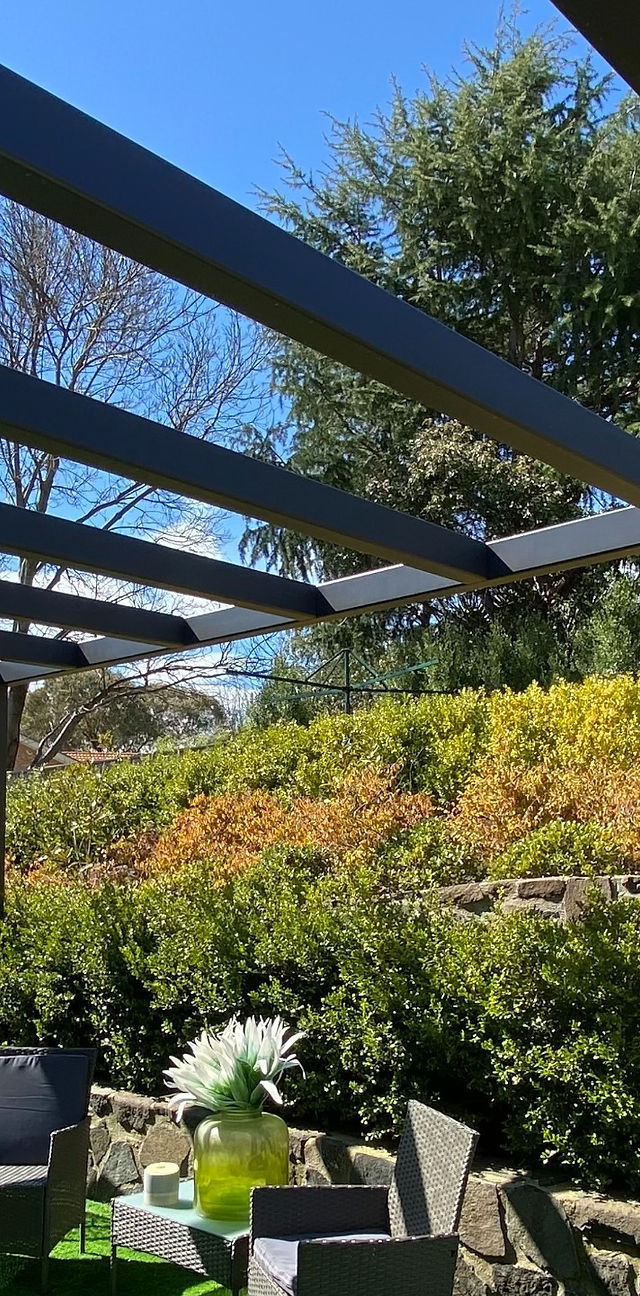
In the Canberra area, Pergolas installation and Decking Solutions offers high-quality new builds/installations, enhancements, renovations, and repairs to decks, pergolas, carports, and other outdoor structures. We design unique outdoor living areas and carports that go above and beyond your expectations and enhance your way of life. Get in touch with us right away for a no-obligation quotation if you want to add value to your house by turning an outside space into an useable entertainment area that can be used all year round for entertaining family and friends. You might also just want to add a carport. We assist you to make it simple.
We create and develop specialised solutions to fit your needs and available space. From colorbond steel to high performance insulated roofing panels for usage in diverse architectural, residential, and commercial applications, we provide a variety of roofing alternatives. Insulated roofing panels reduce the amount of unattractive support beams often used in conventional roofing techniques and give a weather-tight cover, excellent insulation, maintenance-free operation, and a crisp unbroken ceiling finish. decking solutions The panels will not only keep you cool in the summer and warm in the winter, but they will also create a cosy ambiance for entertaining or just relaxing in your covered outdoor area. The panels, which come in a number of hues and treatments, including the brand-new wood appearance finish, are very sturdy and will last for years to come, enabling you to enjoy your pergola.
Additionally, our carports may be tailored to your needs in terms of design and area. We may design and construct independent carports or carports that are connected to your home in a variety of ways. To guarantee that your carport will survive the weather, protect your automobile, and continue to look great years after installation, we utilise powder coated aluminium posts and beams and colorbond steel roofing panels. There is bound to be a colorbond shade for the roofing panels that matches your home's or your style. We provide and construct decks utilising modern composite materials, which are rapidly gaining favour, together with natural wood or an aluminium or steel substructure. visit us online at http://www.pergolaanddeckingsolutions.com.Au/
10 notes
·
View notes
Text
Lacking the dangerous charisma of other Aussie undesirables, such as red-back spiders, funnel-webs or tiger snakes, these largish, muddy-brown insects were the embodiment of abject otherness, their persistent knocking against uncurtained windows and sneaky incursions into closely guarded domestic interiors summoning inchoate fears and feelings of revulsion. [...] [T]he Great Invasion of 1969, when [...] the nation’s capital fell prey to such a large bogong infestation that the automatic lifts and air-conditioning shafts of some high-rise office buildings were blocked by resting moths, while parts of the city even suffered power failures [...].
Within the public space of the federal capital, the world of the Kamberri is recalled in the guise of sundry bogong sculptures, such as those that grace the grounds of the Australian Institute of Aboriginal and Torres Strait Islander Studies on the Acton Peninsula, once a major corroboree site.

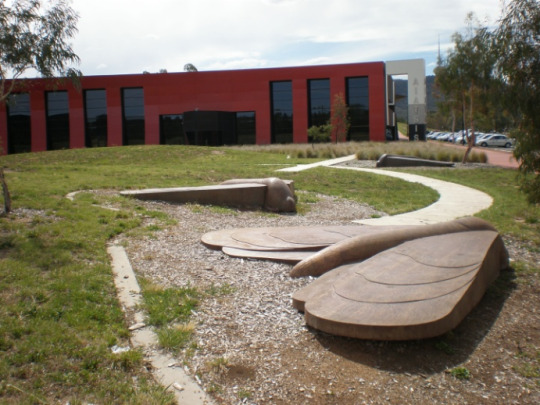
In Australia, Agrotis infusa, as it is known to Western science, typically begins and ends its life-cycle on the slopes and plains west of the Great Dividing Range in northern New South Wales and southern Queensland. Each spring, swarms of adult moths fly south into the Snowy Mountains of southern New South Wales and northern Victoria in search of the cool dark crevices in alpine blockstreams, cavernous piles of granite boulders, where they while away the hot summer months in a process known as ‘aestivation’. There they make themselves collectively cosy during the day by tucking their heads under one another’s wings, covering the rock walls like scales or roof tiles. [...]
The urge to set off on this annual migration appears to be triggered by the drop in barometric pressure that accompanies the formation of summer storms. The moths travel by night, upwards of 1,000 kilometres in some cases, feeding on nectar along the way, and dropping down to ground to shelter during the day. This was always a potentially perilous journey, but it became a whole lot more so during the twentieth century. In addition to the perennial risk of being blown off course and towards the eastern seaboard by westerly storm winds, the growth of towns illuminated ever more brightly by electric lights has proven a not infrequently fatal attraction for migrating moths. It is thought that the lights ‘fool the moths into behaving as if the sun was coming up. Their natural response is to dive down to the ground to find a dark place before the heat of the day sets in. … Buildings can become covered with a thick coating of moths, desperately seeking dark cracks and crevasses to hide from the sun’ (‘Bogong Moths Migrating South’). Those that end up in Sydney, not to mention Melbourne, have gone seriously astray, probably as a result of stormy weather; but Canberra is right in their flight path, and, in addition to the domestic illumination of its sprawling suburbs, the 40,000 lights of the New Parliament House, with its elevated floodlit flagpole beckoning from afar, burn long and strong.


Bogongs that manage to survive the risks posed by storms, predators, poisons and the odd book-wielding student during their southern sojourn, return north to their breeding grounds in the relative cool of the autumn. Now that they are all grown up, they duly mate, whereupon the pregnant females cleverly lay their eggs on the stems of a variety of food plants. Previously native species, these are now all too often agricultural crops, such as cauliflower, silverbeet, lucerne, flax and sundry cereals. Needless to say, this practice has ensured that bogongs are if anything even more hated by farmers than by city slickers such as myself. When the larvae emerge in the guise of hungry caterpillars, creamy-coloured to begin with, then green, and finally grey, black or orange-brown in hue, they each make themselves a snug burrow in the soil at the base of their host plant. There they hide by day, craftily emerging under the cover of darkness to feed. This nightly feasting is bad news for seedlings, the stems of which are often gnawed right through, leading bogongs to be classed as a pestiferous ‘cutworm’ and, for the past fifty to one hundred years, regularly doused in an array of biocidal chemicals.
While the causes of this [bugong moth population] decline remain uncertain, the clear-felling of native vegetation in their breeding grounds and liberal use of biocides on the cropland that has replaced it are likely to be factors (Keaney). The industrial production of preferred settler Australian foodstuffs, and possibly other lucrative plants, in the bogong breeding grounds also appears to be threatening more than the moths themselves.
A paper published in 2001 (Green et al.) found that the raised levels of arsenic found in the outwash areas of those caves where bogongs had been aestivating over summer indicated that the moths were importing poison into the alps. Moreover, arsenic was also found in the faeces of mammals that prey on them, including bats and mountain pygmy possums, an already endangered species. The source of this arsenic could well be from accumulations in the soil, a legacy of its former use in pesticides, as well as in cattle and sheep dips, in lowland agriculture: the story of the bogong discloses connections across time as well as space.
---
Photos, captions, text from: Kate Rigby. “Getting a Taste for the Bugong Moth.” Australian Humanities Review. May 2011.
26 notes
·
View notes
Text
Roof Works Canberra- Find the Right Professional for the Job
When you have a roofing problem you should hire a professional to do the work. Here we look at some ways to go about finding such a professional.
When it comes to your roof it is advisable to enlist the help of a professional. If your roof needs to be replaced you can do it yourself if you are proficient in this area. However to save time and to guarantee that the entire roofing system will be installed in the manner it is supposed to be it is highly recommended that you find a qualified and experienced roofer to do the job. He will know every important step that must be taken in the process.
When it comes to choosing a roofer who is suitable for the job it is always wise to obtain several quotes. Aim for at least three. Once you have these quotes then compare them. This will help you to figure out what a new roof will cost you as well as what types of labor costs will accompany the work.
Make sure that each quote addresses the same aspects of getting a new roof. This will make it easier to compare each quote. For example, ensure that each roofing company quotes you on such things as shingles, eave protectors, underlayment, required ventilation and so on. It is important as well that the roofer you hire is willing to stand behind the work he does. This is important because in most instances warranties for roofs do not cover the improper installation of such.
In looking to hire roofers one of the best places to start is with organizations that roofers belong to. Look for certified organizations in your community. These are very well qualified experts in the field who are governed by a strict set of guidelines that have been laid down for them to guarantee that the work they do is of the highest quality and done with extreme care. Anyone that signs on with such a professional organization must be licensed and must have adequate liability insurance.
Roof Works Roof Restoration is a professional Canberra Roofing company that can make the difference in your home. It specializes in all kinds of roof works such as Roof Restoration Canberra, Roof Painting, Roof Coatings, Roof Repairs Canberra, etc all around Canberra. Learn more at http://www.roofworksroofrestoration.com.au.
#Roof Works Canberra#Canberra Roofing#High Pressure Cleaning Canberra#Exterior Painting Canberra#Roof Cleaning Canberra#Tile Restoration Canberra#Roof Repairs Canberra#Roof Coatings Canberra
0 notes
Text
Honey bees and Wasps – Pest Control in Canberra
Canberra is home to numerous wasp and honey bee species, including the well known European bumblebee (Apis mellifera) and the European wasp (Vespula germanica). Despite the fact that Canberra's honey bees are considered non-undermining (except if you're hypersensitive to them), it's anything but an alternate story. A1 Pest Control Canberra – the main supplier of vermin control administrations in Canberra – can help you bargain rapidly and proficiently with honey bees and wasps.
https://www.pinterest.com.au/pin/1076571485894953435
Get to recognize more about Bees & Wasps
Bees
Honey bees aren't by, and primarily viewed as vermin, as they assume an indispensable part in the fertilization of numerous local plants. On the off chance that you have a honey bee home close to your home that isn't causing issues, it's likely best to let it be. A house arranged in your home (generally in a divider or rooftop cavity) can usually be moved by an enrolled beekeeper. In situations where a beekeeper can't move house (because of access limitations), bug control is usually the solitary choice.
Asian paper waspThe Asian paper wasp is an as of late presented species bigger and more bright than the regular paper wasp. An extraordinary quality of the species is that a foundress (female organizer) once in a while participates in human flesh consumption (eats its hatchlings) when food is scant. It's anything but known precisely how the Asian paper wasp entered Australia. However, the species is grounded in Japan, China, Korea, Mongolia and New Zealand. Its eating regimen and living space are like the regular paper wasp.
European wasp
The European wasp is an acquainted species that initially accompanied the consideration of Australian entomologists in 1959. The European wasp is a forcefully fabricated creepy-crawly that can sting over and over without biting the dust (in contrast to honey bees). Bug regulators in Canberra generally get the callout for European wasps in summer – when a home begins to fill in size.
European wasps are more forceful than honey bees and will assault people if their homes are upset. In Canberra, European wasps begin reproducing vigorously in pre-summer/late-spring – making enormous public homes all the while. The houses are typically found in the ground or rooftop and divider holes. European wasps are drawn to pet meat and sweet food varieties/drinks.Yellow jacket (social wasp)The social wasp (Vespula spp.) – otherwise called a yellow coat – is comparative in appearance to the European wasp yet has dark spots all over. The social wasp breeds in spring and assembles its home in divider and rooftop pits, just as under overhang, patios and floors. However, social wasps will begin eating creepy crawlies but progress to better food sources over the mid-year.Common paper waspThe standard paper wasp is more modest and less forceful than the European wasp, yet at the same time equipped for conveying a frightful sting. Like the European wasp, the paper wasp fires reproducing in spring and wraps up in early pre-winter. Paper wasps, as a rule, make their tiny homes in divider cavities, on the wall and under house roofs. Paper wasps appreciate organic product mash/nectar and different creepy crawlies (caterpillars, small arachnids, moths, butterflies) as far as diet.
The end of wasps in or close to your house is significant, particularly if you have youngsters. Wasps not just have a dreadful sting (which a few groups are adversely affected by) but can also destroy your inside divider mortar.
Kindly call the accomplished group for more data on
wasp and honey bee bug control management in Canberra.
Source:
Rat and Mouse Pest Control
Also visit:
-
Wasp and Bee
-Wasp and bee control
0 notes
Text
Celebrating science | Australian Academy of Science
December 01, 2020
2020: it’s been huge.
As we depend down the ultimate days of what has been an sudden 12 months, be a part of us as we replicate on the challenges and successes skilled by the Australian Academy of Science over the past 12 months. And, as we look forward to a greater tomorrow, we can be celebrating science and the leaders who will information us there.
Keep watch over the Academy social media channels via December as we share movies and profile articles introducing the 2020 cohort of Fellows elected earlier this 12 months. We may also revisit among the largest tales we coated via the 12 months. You’ll be able to comply with the Academy on Facebook, Twitter, Instagram and LinkedIn or subscribe to our monthly newsletter.
However for now, let’s have a fast look again on the 12 months that was:
vimeo
January
2020 began with a lot of Australia on hearth, prompting a transparent statement from the Academy President Professor John Shine on how human-induced local weather change will proceed to extend the frequency and severity of utmost climate. It wasn’t lengthy earlier than Canberra skilled one other type of excessive climate, with a severe hailstorm inflicting catastrophic harm to the copper roof of our beloved Shine Dome, threatening the Academy’s distinctive and invaluable scientific archives. Ian Potter Home, the place a lot of the Academy’s employees work, was additionally broken to the purpose of being unsafe to occupy. For a lot of employees members, this was the start of ‘working from residence’.
February
In February, the Academy co-hosted the Catalysing Gender Equity conference the place a whole lot from throughout the Australian STEM sector, together with twelve changemakers from the STEM Ladies on-line neighborhood, travelled to Adelaide to debate advance gender fairness in Australia and realise the alternatives described within the Decadal Plan for Women in STEM. The SAGE Athena SWAN awards had been additionally held for the final time whereas SAGE was in its pilot part. The Academy stands alongside co-founding accomplice, the Australian Academy of Expertise and Engineering, in wishing SAGE Ltd a powerful and profitable future.
March
youtube
Our first Newest From Science video responding to COVID-19.
The honorific awardees for 2020 had been introduced in March, with 18 gifted scientists recognised for his or her important contributions to Australian science. Keep watch over our social platforms as we revisit these discoveries and careers over the approaching weeks. March additionally noticed the implementation of COVID-19 restrictions nationally, and the Academy responded by making a name for the info underpinning COVID-19 selections to be made public, and launching of a collection of factual videos to help neighborhood consciousness.
April
In early April, the COVID-19 Expert Database was launched offering entry for decision-makers and journalists to key consultants related to the pandemic. Later that month, together with Australia’s Chief Scientist and different realized academies and companions, we additionally launched the Rapid Research Information Forum (RRIF) to offer the very best obtainable proof to quickly reply to urgent questions on COVID-19 thereby supporting authorities decision-making in response to the pandemic. RRIF has to date supplied 13 briefs together with extra updates.
Might
Might would usually be one of many largest months within the Australian science calendar with our annual Science on the Shine Dome occasion. This 12 months we nonetheless introduced the 2020 cohort of Academy Fellows and Corresponding Members—keep watch over our social channels throughout December as we recognise every of the brand new Fellows individually for his or her contribution to science and Australia. In Might we additionally warned resolution makers that the response to the pandemic risked wiping out most of the hard-won features for women in STEM.
June

International Science TV host, journalist and scientific psychologist Nuala Hafner.
On World Surroundings Day, the Academy joined 17 different academies to name on world governments to make sure a sustainable recovery from the pandemic. June additionally noticed the launch of a brand new outreach initiative, Global Science TV, a collaboration with the Worldwide Science Council that developed from the science information functionality developed on the Academy over the past three years.
July
In July we revisited the bushfire season, with Fellows offering proof to Authorities by way of senate estimates and proof briefs on the impact of the fires on soil health, biodiversity and later, the health impacts. A reminder was additionally issued by the InterAcademy Partnership (IAP) that solely a low-carbon restoration will present for social fairness, the atmosphere, and human well being. The Academy program, Future Earth Australia, additionally known as for local community needs to not be neglected as we adapt to local weather change.
August

A drone picture of our message for the Satellite tv for pc Selfie, assembled by Academy employees.
Throughout August, we celebrated National Science Week with two on-line webinar occasions on saving our oceans and combating bushfires with science. We additionally co-hosted a dialogue with the Australian Academy of Law on the reception, high quality and analysis of scientific proof in Australian courts. A satellite selfie was taken from house of the Shine Dome, and we took the chance to share extra inspiring stories of the Academy’s Fellows. We additionally took a glance again on the previous 12 months of championing the vision for women in STEM, applauding the successes and recognising the place extra work nonetheless must be performed.
September
In September, we made a name for data governance standards in sport, recognising the dearth of oversight in how information is being collected and the related impacts on athletes’ rights and protections. We additionally held the Australian remaining of Falling Walls Lab and recognised three profitable concepts from early profession researchers who then represented Australia within the worldwide finals held in Berlin, Germany.
October
October noticed the discharge of the delayed Federal Budget, which signalled a big response to the disaster dealing with Australia’s scientists because of the pandemic. The Academy additionally contributed a coverage temporary to the parliament recommending the event of an impartial nationwide biodiversity agency, or ‘biodiversity BOM’, to be the custodian of biodiversity information in the identical manner BOM manages nationwide climate information.
November

A scan from our archives of Mawson, David and Mackay on the South Magnetic Pole. The digital camera was operated by way of a string.
Throughout November, we celebrated NAIDOC Week with two inspirational webinars that explored how Aboriginal and Torres Strait Islander peoples have data that stretches again 1000’s of years and have a lot to contribute to Australia’s future. We additionally introduced the repair work to the Shine Dome, and a dedication in direction of net zero emissions at Australia’s home of science. We’ve additionally begun digitising the first of many collections within the Academy archives, which have already been accessed by researchers internationally.
December
Lastly, throughout December we can be Celebrating Science. Over the following 4 weeks we are going to share movies introducing the 2020 cohort of Fellows elected earlier this 12 months. We may also revisit among the largest tales we coated via the 12 months as we put together for what 2021 will deliver.
The Academy has so many to thank for his or her help all through 2020. Companions and sponsors from the personal, authorities, science and training sectors, together with many beneficiant donors, have made it attainable for the organisation to realize what it has this 12 months. We are going to proceed to recognise our supporters’ contributions within the second version of Science Issues within the first half of 2021.
And we acknowledge the laborious work of all our Fellows who make the Academy what it’s. The Academy’s Fellowship of good minds makes main contributions to the success and prosperity of Australia.
Source link
from Diaspora9ja https://diaspora9ja.com/celebrating-science-australian-academy-of-science/?utm_source=rss&utm_medium=rss&utm_campaign=celebrating-science-australian-academy-of-science
0 notes
Text
Expert Roofing Services in Canberra - From Installations to Repairs

When it comes to choosing the right roofing material for your home, metal roofing has become an increasingly popular choice among homeowners. Renowned for its durability, longevity, and stylish appearance, metal roofing offers a perfect blend of functionality and aesthetics. However, selecting the right metal roofing experts is crucial to ensuring a successful installation and maximizing the benefits of this innovative roofing solution. In this guide, we will explore why metal roofing is an excellent option and how our team of metal roofing masters can help you achieve your roofing goals Metal Roofing Experts Canberra.
The Benefits of Metal Roofing
1. Exceptional Durability
One of the standout features of metal roofing is its durability. Unlike traditional roofing materials such as asphalt shingles or wood, metal roofs are designed to withstand harsh weather conditions, including heavy rain, strong winds, and extreme temperatures. Metal roofing can last 40 to 70 years, depending on the material used, making it a wise investment for any homeowner.
2. Energy Efficiency
Metal roofing is also known for its energy-efficient properties. The reflective nature of metal helps to deflect sunlight, keeping your home cooler in the summer months. Many metal roofing systems are coated with special reflective paint that can further enhance energy savings. This energy efficiency can lead to lower cooling costs and increased comfort in your home.
3. Aesthetic Appeal
Metal roofs are available in a wide range of colors, styles, and finishes, allowing homeowners to choose a design that complements their home's architecture. From sleek standing seam panels to traditional shingles that mimic the look of slate or tile, metal roofing offers versatility that can enhance your home’s curb appeal.
4. Low Maintenance
Another advantage of metal roofing is its low maintenance requirements. Unlike other materials that may need regular inspections, cleaning, or repairs, metal roofs are generally resistant to issues such as rot, mold, and insect damage. A simple annual inspection and occasional cleaning are usually all that’s needed to keep your metal roof in top shape.
5. Environmentally Friendly
For eco-conscious homeowners, metal roofing is an attractive option. Most metal roofing materials are made from recycled content, and at the end of their long lifespan, they can be recycled again. This sustainable approach minimizes waste and reduces the environmental impact of roofing materials.
Why Choose Metal Roofing Masters?
Expertise and Experience
At Metal Roofing Masters, we pride ourselves on our expertise and years of experience in the roofing industry. Our team of skilled professionals understands the intricacies of metal roofing installation and maintenance, ensuring that each project is executed with precision and care. We stay up-to-date with the latest techniques and materials, allowing us to provide our clients with the best possible solutions.
Customized Solutions
We recognize that every home is unique, which is why we offer customized metal roofing solutions tailored to your specific needs and preferences. Whether you’re looking for a sleek modern design or a classic look, our experts will work with you to choose the right style, color, and material that fits your vision and budget.
Quality Materials
We are committed to using only the highest quality materials in our roofing projects. Our metal roofing products are sourced from reputable manufacturers, ensuring durability and longevity. By choosing Metal Roofing Masters, you can rest assured that your roof will be built to last.
Comprehensive Services
From initial consultation and design to installation and post-installation support, we offer a full range of metal roofing services. Our team will guide you through every step of the process, providing expert advice and assistance to make your roofing experience as smooth as possible.
Customer Satisfaction
Customer satisfaction is our top priority. We believe in building lasting relationships with our clients, and our numerous positive reviews speak to our dedication to quality workmanship and exceptional service. We take the time to listen to your needs, address your concerns, and ensure you are completely satisfied with the final result.
Conclusion
Metal roofing is an outstanding choice for homeowners looking for a durable, stylish, and low-maintenance roofing solution. With the expertise of Metal Roofing Masters, you can enjoy the many benefits of metal roofing while ensuring a seamless installation process. Our commitment to quality, customized solutions, and customer satisfaction sets us apart as the go-to experts in the field. Whether you’re building a new home or upgrading your existing roof, trust Metal Roofing Masters to deliver the perfect roofing solution for your needs. Let us help you protect your home and enhance its beauty with a top-quality metal roof that will last for decades to come!
0 notes
Text
Happy New Year!
I think the thing that surprised me most was how deluded we were. The Currowan fire was enormous, bigger than anything anyone had any experience with. The longer a fire burns, the hotter it gets, and this had been burning for weeks. I knew it was dry, you could see it on the ridges - they were browning off. Not dead, but getting there. We’d been mountain biking frequently up the back of Maulbrooks Road, to the west of Mogo. We knew it was crisp-dry.
I had checked the fire prediction map the night before, and even though it showed ember attack on the eastern side fo the highway, I still could not believe that suburbs like Malua Bay or Catalina would be affected. They were just too….suburban. Yet, when I look at the map now it’s clear that Malua Bay, Tomakin, Broulee, Rosedale etc.,. lie at the eastern end of a huge, uninterrupted tract of bush directly to the northwest, bush that had an active fire in it, a fire that had been burning for weeks, in unprecedented dry conditions. These brick and tile suburbs, with their lawns and trampolines and boat trailers, were basically at the end of a gun barrel.
Map showing the track of the NYE fire

It took days to get information about the local area. I could call anyone in any city on the planet on the landline, but no-one closer than Nowra.
Eurobodalla Council had run a campaign leading up to Christmas to get Canberra holiday makers back to the coast (they’d been staying away due to the smoke and threat of road closures). Now the Kings Highway from Batemans Bay was closed, the Princes Highway was closed and the only way out was to the south. Many were now stuck in the region with kids, caravans, trailers and boats. The trouble was, there was no fuel. All the petrol stations had fuel but no power to pump it with. It took a couple of days for generators to reach Moruya, under escort through the road closures, in order to pump fuel. Canberrans had to drive up Brown mountain through Cooma, the road was later closed due to fires in that area too.
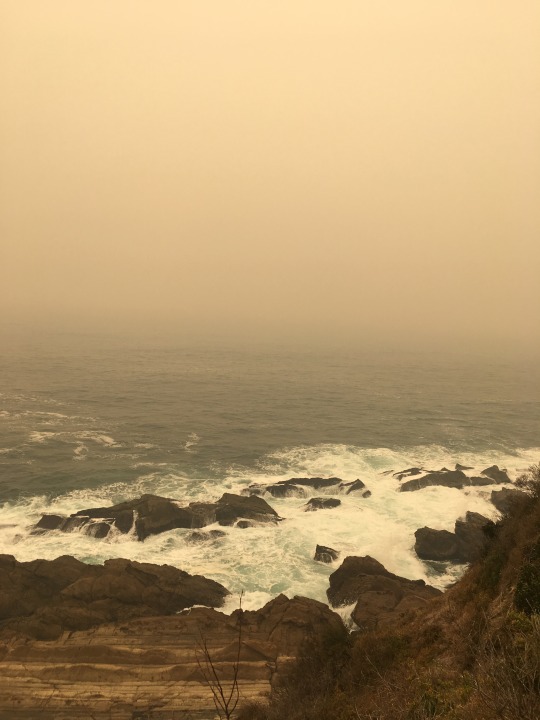
Moruya Heads, New Year’s Day. The smoke and ash prevented communications and radio, as well as blocking out light for solar panels.
We drove the 8kms to T’s Dad’s place. His house, like many others locally, is off-grid and relies on solar. He had about one day before his power, that also operates his water pumps, ran out, as the ash coated his panels and also prevented sunlight. T climbed up on the roof and cleaned the panels and then we went home. We had water, a flushing toilet, solar hot water but no power. We told our daughter it was like camping but in your own bed.
It was OK. We bought a couple of boxes of veges off our neighbours from Queen St growers, one for us, one for T’s Dad and partner. We had rice, eggs, pasta, lentils, a substantial metho stove with fuel and an Engel fridge in the van that we stopped using once we ran out of milk.
Our diet was a little more vegan than usual - each morning I made porridge with coconut milk, chopped almonds and honey, and we ate a lot of beans and veges for the rest of the meals. We had two cars, one of which was in town with a full tank of diesel, the other at home and running on fumes. T’s work van had half a tank and sat in the driveway, slowly being filled up with tools.
Neighbours dropped in and told us they’d ‘circled the wagons’ at the evacuation centre at the Moruya showgrounds, and camped together, but that it was noisy, unhygienic and there were dogs roaming everywhere. Our next-door neighbours returned home from the evacuation centre, offering us their generator powered fridge if we needed it.
I went into town to Southlands (grocery store), which was letting people in on a one-in one-out basis. Outside I ran into friends and neighbours who’d left the Heads and were staying in town, all with friends. We hugged and caught up with each other. She told me that there was no fuel, batteries or hoses left at the hardware store. She'd been on an unsuccessful hunt that morning for a P2 mask.
Inside the grocery shop was dark with the power still out, but the food was fresh as they’d loaded up their old refrigerated truck as the fires came through. I didn’t buy much - we didn’t need much - just some avocados, passata and a bit of fruit. Nearby there was a long queue outside the pharmacy, people who I was told her waiting for their methadone. They waited more than three hours for the doors to open.
While I was in town my phone got a bar of service and I checked Instagram. A good friend who lives just outside Bega posted about the Cobargo fire, and how many friends had lost their homes. It was the first sense of the magnitude of the fire that ripped eastwards through Cobargo at dawn on New Year’s Eve.
After two and a half days we managed to get ABC Illawarra on the car radio. It was only then that we heard that about 400 houses had been lost in the 20km of suburbs directly to our north, and estimates of another 400 lost in the Bega Shire. It was unbelievable.
I heard a couple of interviews, one who was a career firefighter who described the fire as more fierce than anything he’d ever seen, creating its own tornado winds and just levelling everything in its path. The bush was so dry that fires were able to get hot enough to become weather driven (instead of fuel driven). This meant they could burn across open paddocks, burning little more than just the air ahead of them. He was describing fireballs that travelled across open country, at the speed of the wind.
We heard more stories from people further north, stories about people running for their lives onto the beaches at Malua Bay. People driving to a beach and then realising it didn’t have enough sand between them and the flames. People jumping into the surf at Rosedale and almost drowning in the big southerly swell running. I heard that rest home residents abandoned their ‘emergency place’ - the dining room - and started hosing down the burning debris that landed up against the buildings.
Many people had moved to evacuation centres, but the toilets at the Showgrounds were on an electricity operated pump system, and quickly failed. UOW’s campus at Batemans Bay was used as an evacuation centre for elderly residents from a couple of local rest homes. They sat in their wheelchairs for hours, while the temperature inside the building rose. There was no air-conditioning and no ability to open the windows, or even the main front door. Once the front door was manually opened it had to be manned by a security guard to stop people who weren’t elderly evacuees from entering.
I heard later that the elderly sent to the UOW campus were there because the evacuation centre at Hanging Rock, opposite the UOW campus, was overflowing. There was nowhere near enough chairs, so many elderly were sitting outside on the concrete. I also heard that many of those evacuated were ‘on oxygen’ and arrived at the campus with their O2 lines connected to their noses and masks, waiting to ‘plug in’ to the O2 at UOW. However, UOW Batemans Bay does not keep oxygen readily available. So, there were elderly people sitting in wheelchairs, requiring oxygen but with none available. One witness told me that an off duty nurse said, ‘These people will start dying in a matter of hours without oxygen’.
Ten day’s later, I was at a dinner with friends when a woman told me that Andrew Constance had visited the UOW campus and called the premier, Ms Berejiklian and told her she needed to get the people out of the campus or else it was going to be on the front pages of every newspaper in the country. Multiple ambulances collected the evacuees and took them back to their respective rest homes. This woman was proud of Mr Constance for his decisive action.
Another person at the table said, “So the state government ignores climate change, then ignores the immediate warnings about a bushfire catastrophe, doesn’t plan anything at all and then when it all turns to shit on their watch, one of their team gets to ride in a look like a hero for saving the day?”
It was one of many, many tense conversations in the weeks that followed.
Many stories we heard were also inaccurate. We heard that Mogo was completely gone, that Mossy Point was completely on fire, that Broulee itself had lost hundreds of houses. We heard that the Princes Highway was still burning at Bimbimbie and would take months to be repaired. I managed to text a friend and colleague who lives in Catalina. We have another colleague and friend at Jeremadra, and I was very worried about her. The text came back - she’s OK and we think her house is still there.
This was what it was like - we’ve lived here for many years, we know thousands of people. There was also the brutal knowledge that the southerly that ‘saved us’ would most definitely have spelled disaster for others. It’s a terrible feeling of weird relief and guilt.
And every night I’d make sure the phone volume was turned all the way up, in the hope that one of my city friends might call the landline if we didn’t receive an emergency text. Our neighbour left their south facing windows open so they’d be woken by any glow that might appear on the hill behind us. I woke many times every night and stood outside looking for glowing red or orange to the north of or south.
At some point the state government issued a state of emergency but that meant nothing to anyone as far as I knew. There was still no power and no communication.
A neighbour came down for a coffee and said he was worried about all the junkies drying out. We laughed and talked about everyone going a bit mad and paranoid. This was not helped by the numerous stories of looting going around, as some suburbs were evacuated and people weren’t allowed back in once they’d left.
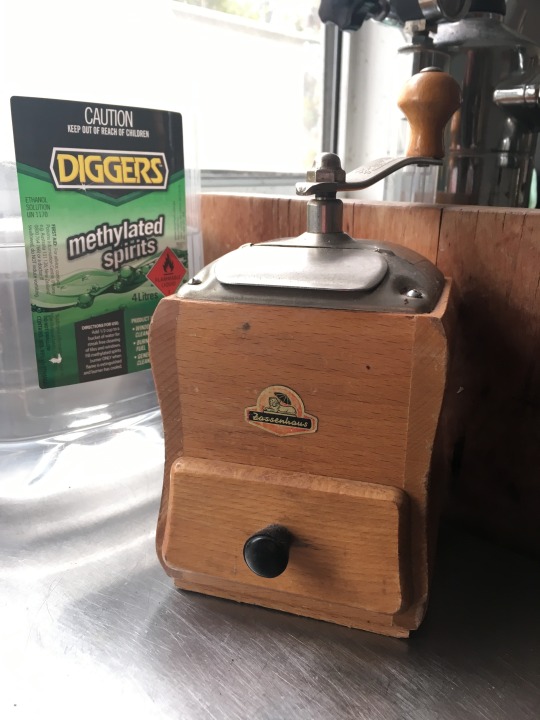
Always, ALWAYS make sure you have the ability to make coffee
For three days after NYE the RFS was issuing extremely serious warnings about the coming Saturday (the 4th). As everyone gradually started to see and share images of the destruction on whatever limited communication they had, the panic started to set in.
The suburb remained fairly empty. NYE was a Tuesday. We were warned by the RFS on the radio that Saturday was the real danger day. Our neighbour came by and told us the RFS wanted everyone out of the Heads for the 4th.
This was not a mandatory evacuation, and we were told to place our recycling bin outside the house to indicate we were home. Days later I saw another neighbour on the beach. She asked if we’d gone to the community meeting in town on the Friday before the ‘Saturday fire day’. I said no, we didn’t know anything about it. She said,
“If you’d been there there’s no way you would have stayed. They told us that the RFS would not be defending the Heads at all, and that they were only going to defend the town (Moruya)”.
Lucky we didn’t go to the meeting then!
We kept checking the forecast leading up to Saturday - it showed an early northerly and then noreast for our place. We started to feel a little more confident - a strong NNE would likely be more onshore for us at the coast, protecting us to the north. The Fire Spread Prediction Map showed us as the only tiny little avenue of untouched area. This was comforting but we were also aware of how inaccurate the previous NYE map had been, showing Malua Bay etc.,. as untouched and yet they burned.

We decided that I would evacuate into Moruya the night before with the kid and the dog, and T would ‘stay and defend’. It was a mad few days prepping the house. T cut sheets of corrugated iron for all the doors and windows, rigged up a watering system, cut down many of trees and branches. We packed everything we felt we ‘couldn’t live without’ into the cars and the van, including two huge tubs of Lego.
Days later, when we finally felt like we could unpack everything, I found this little message written next to the windowsill in our daughter’s room;

We moved all the cars into town, leaving T at the house with his electric mountain bike. There’s only one road into the Heads, and it’s flanked in sections by bush. T thought that if that road was cut, or the road to the beach was cut he’d have a better chance across the paddocks or through the bush on his bike. And with that, we waited for our second “fire day”.
0 notes
Text
88 Crazy Things You Probably Didn't Know About Australia
1. Australia is as wide as the distance between London to Moscow.
2. The biggest property in Australia is bigger than Belgium.
3. More than 85% of Australians live within 50km of the coast.
4. In 1880, Melbourne was the richest city in the world.
5. Gina Rinehart, Australia's richest woman, earns $1 million every half hour, or $598 every second.
6. In 1892, a group of 200 Australians unhappy with the government tried to start an offshoot colony in Paraguay to be called 'New Australia'.
7. The first photos from the 1969 moon landing were beamed to the rest of the world from Honeysuckle Tracking Station, near Canberra.
8. Australia was the second country in the world to allow women to vote (New Zealand was first).
9. Each week, 70 tourists overstay their visas.
10. In 1856, stonemasons took action to ensure a standard of 8-hour working days, which then became recognised worldwide.
11. Former Prime Minister Bob Hawke set a world record for sculling 2.5 pints of beer in 11 seconds. Hawke later suggested that this was the reason for his great political success.
12. The world's oldest fossil, which is about 3.4 billion years old, was found in Australia.
13. Australia is very sparsely populated: The UK has 248.25 persons per square kilometre, while Australia has only 2.66 persons per square kilometre.
14. Australia's first police force was made up of the most well-behaved convicts.
15. Australia has the highest electricity prices in the world.
16. There were over one million feral camels in outback Australia, until the government launched the $19m Feral Camel Management Program, which aims to keep the pest problem under control.
17. Saudi Arabia imports camels from Australia (mostly for meat production).
18. Qantas once powered an interstate flight with cooking oil.
19. Per capita, Australians spend more money on gambling than any other nation.
20. In 1832, 300 female convicts mooned the governor of Tasmania. It was said that in a "rare moment of collusion with the Convict women, the ladies in the Governor's party could not control their laughter."
21. Australia is home to the longest fence in the world. It is 5,614 km long, and was originally built to keep dingoes away from fertile land.
22. Australia was one of the founding members of the United Nations.
23. Melbourne is considered the sporting capital of the world, as it has more top level sport available for its citizens than anywhere else.
24. Before the arrival of humans, Australia was home to mega fauna: three metre tall kangaroos, seven metre long goannas, horse-sized ducks, and a marsupial lion the size of a leopard.
25. Kangaroos and emus cannot walk backward, one of the reasons that they're on the Australian coat of arms.
26. Speaking of, Australia is one of the only countries where we eat the animals on our coat of arms.
27. If you visited one new beach in Australia every day, it would take over 27 years to see them all.
28. Melbourne has the world's largest Greek population outside of Athens.
29. The Great Barrier Reef is the planet's largest living structure.
30. And it has it's own postbox!
31. The male platypus has strong enough venom to kill a small dog.
32. And when the platypus was first sent to England, it was believed the Australians had played a joke by sewing the bill of a duck onto a rat.
33. Before 1902, it was illegal to swim at the beach during the day.
34. A retired cavalry officer, Francis De Groot stole the show when the Sydney Harbour Bridge officially opened. Just as the Premier was about to cut the ribbon, De Groot charged forward on his horse and cut it himself, with his sword. The ribbon had to be retied, and De Groot was carted off to a mental hospital. He was later charged for the cost of one ribbon.
35. Australia has 3.3x more sheep than people.
36. Prime Minister Harold Holt went for a swim at Cheviot Beach, and was never seen again.
37. Australia's national anthem was 'God Save The King/Queen' until 1984.
38. Wombat poop is cube shaped! This helps it mark its territory.
39. European settlers in Australia drank more alcohol per capita than any other society in history.
40. The Australian Alps receive more snowfall than Switzerland.
41. A kangaroo is only one centimetre long when it is born.
42. Sir John Robertson, a five-time premier of NSW in the 1800s, began every morning with half a pint of rum. He said: "None of the men who in this country have left footprints behind them have been cold water men."
43. The Box jellyfish has killed more people in Australia than stonefish, sharks and crocodiles combined.
44. Tasmania has the cleanest air in the world.
45. The average Aussie drinks 96 litres of beer per year.
46. 63% of Australians are overweight.
47. Australia is ranked second on the Human Development Index (based on life expectancy, income and education).
48. In 2005, security guards at Canberra's Parliament House were banned from calling people 'mate'. It lasted one day.
49. In Australia, it is illegal to walk on the right-hand side of a footpath.
50. Australia is the only continent in the world without an active volcano.
51. Aussie Rules footy was originally designed to help cricketers to keep fit in the off-season.
52. The name 'Kylie' came from an Aboriginal hunting stick, similar to the boomerang.
53. 91% of the country is covered by native vegetation.
54. The largest-ever victory in an international football match was when Australia beat American Samoa 31-0 in 2001.
55. There are 60 designated wine regions in Australia.
56. Melbourne has been ranked the world's most liveable city for the past three years.
57. If all the sails of the Opera House roof were combined, they would create a perfect sphere. The architect was inspired while eating an orange.
58. Australia is home to 20% of the world's poker machines.
59. Half of these are found in New South Wales.
60. Moomba, Australia's largest free festival, held in Melbourne, means 'up your bum' in many Aboriginal languages.
61. No native Australian animals have hooves.
62. The performance by the Sydney Symphony Orchestra at the 2000 Olympics opening ceremony was actually a prerecording- of the Melbourne Symphony Orchestra.
63. The wine cask (goon sack) is an Australian invention
64. So is the selfie.
65. Durack, Australia's biggest electorate, is larger in size than Mongolia.
66. The world's first compulsory seat belt law was put into place in Victoria in 1970.
67. Each year, Brisbane hosts the world championships of cockroach racing.
68. In 1932, the Australian military waged war on the emu population of Western Australia. Embarrassingly, they lost.
69. Canberra was created in 1908 as a compromise when Sydney and Melbourne both wanted to be the capital city.
70. A gay bar in Melbourne won the right to ban women from the premises, because they made the men uncomfortable.
71. In 1992, an Australian gambling syndicate bought almost all the number combinations in a Virginia lottery, and won. They turned a $5m purchase into a $27m win.
72. Eucalyptus oil is highly flammable, meaning gum trees may explode if ignited, or in bushfires.
73. In 1975, Australia had a government shutdown, which ended with the Queen firing everyone and the government starting again.
74. A bearded Australian was removed from a darts match in the UK, after the audience started chanting 'Jesus!' at him, distracting the players.
75. There have been instances of wallabies getting high after breaking into opium crops, then running around and making what look like crop circles.
76. An Australian man once tried to sell New Zealand on eBay.
77. In 1940, two aircraft collided in midair, in NSW. Instead of crashing, the two planes became stuck together and made a safe landing.
78. The male lyrebird, which is native to Australia, can mimic the calls of over 20 other birds. If that's not impressive enough, he can also perfectly imitate the sound of a camera, chainsaw and car alarm.
79. Some shopping centres and restaurants play classical music in their car park to deter teenagers from loitering at night.
80. Despite sharing the same verbal language, Australian, British and American sign language are all completely different languages.
81. In 1979, debris from NASA's space station 'Skylab' crashed in Esperance, WA. The town then fined NASA $400 for littering.
82. There have been no deaths in Australia from a spider bite since 1979.
83. There currently a chlamydia outbreak among koala species, which has led to a 15% drop in koala populations.
84. In NSW, there is a coal fire beneath the ground which has been burning for 5,500 years.
85. An Australian election TV debate was rescheduled so it didn't conflict with the finale of reality cooking show Masterchef.
86. Chinese explorers travelled to Australia long before Europeans arrived. As early as the 1400s, sailors and fisherman came to Australia for sea-cucumbers and to trade with Indigenous peoples.
87. The first European to visit Australia was Dutch explorer Willem Janszoon, in 1606. More Dutch explorers visited the country over the next hundred years, plotting maps and naming it 'New Holland'.
88. Captain James Cook first landed on Australia's east coast in 1770. In 1788, the British returned with eleven ships to establish a penal colony. Within days of The First Fleet's arrival and the raising of the British flag, two French ships arrived, just too late to claim Australia for France.
#No littering!#even if you’re NASA#littering is bad!#yes these are all true#yes all our politicians prior to to 2000s were known for drinking#yes some of these I- an Australian- didn’t know#yes this country is batshit crazy sometimes#No I don’t know why melbourne is the most liveable city when I still can’t get a job#not fandom#Australia#we also invented wifi by accident#thank you CSIRO for your contibution to our internet addicions#tip: the number 1 way to break up a bar fight between Australians is to yell#Aussie Aussie Aussie#and they will imediately stop what they’re doing and yell#Oi Oi Oi!#actual facts#post stolen from facebook
0 notes
Text
Carport Solutions Canberra
Customised Carport Solutions in Canberra!

We use powder-coated aluminium posts and beams and colour bond steel roofing panels to ensure your carport can withstand the elements.
This carport building protects your car and looks as good as the day it was installed years from now.
Contact us today for residential and commercial carport needs.
2 notes
·
View notes
Text
Discovering the world
Australia 🇦🇺
Basic facts
Official name: Commonwealth of Australia
Capital city: Canberra
Population: 26.4 million (2023)
Demonym: Australian
Type of government: federal parliamentary constitutional monarchy
Head of state: Charles III (Monarch)
Head of government: Anthony Albanese (Prime Minister)
Gross domestic product (purchasing power parity): $1.79 trillion (2024)
Gini coefficient of wealth inequality: 32.4% (medium) (2020)
Human Development Index: 0.946 (very high) (2022)
Currency: Australian dollar (AUD)
Fun fact: Australia has the largest amount of endemic species.
Etymology
The country’s name is derived from the Latin Terra Australis (“southern land”), the term used for a hypothetical continent in the Southern Hemisphere.
Geography
Australia is located in Oceania and borders the Indian Ocean to the west and the Pacific Ocean to the east. It lies south of Indonesia, Timor-Leste, and Papua New Guinea and northwest of New Zealand.

There are seven main climates: tropical monsoon in the northernmost parts, hot steppe and hot desert in the center, humid subtropical and subtropical highland in the east and southeast, and warm-summer Mediterranean and hot-summer Mediterranean in the southwest. Temperatures range from −5 °C (23 °F) in winter to 35 °C (95 °F) in summer. The average annual temperature is 21.9 °C (71.4 °F).

The country is divided into six states and two self-governing territories. The largest cities in Australia are Sydney, Melbourne, Brisbane, and Perth.

History
7th-5th millennium BCE: arrival of Aboriginal Australians
1st millennium BCE: arrival of Torres Strait Islanders
1606 CE: first European landing
1788-1901: Colony of New South Wales
1825-1856: Van Diemen’s Land colony
1856-1901: Colony of Tasmania
1829-1832: Swan River Colony
1832-1901: Colony of Western Australia
1836-1901: Province of South Australia
1851-1901: Colony of Victoria
1859-1901: Colony of Queensland
1850: Australian Colonies Government Act
1851-1854: Eureka Rebellion
1901: Commonwealth of Australia
Economy
Australia mainly imports from China, the United States, and Japan and exports to China, Japan, and South Korea. Its top exports are coal, iron ore, and liquid petroleum gas.
It is rich in natural resources, such as gold, silver, and copper, and a major agricultural exporter. Services represent 79% of the GDP, followed by industry (16%) and agriculture (2%).

Australia is a member of the Asia-Pacific Economic Cooperation, the Commonwealth, the Five Eyes, the G20, the Pacific Community, and the Pacific Islands Forum.
Demographics
Around 76% of the population is European, while 3% identifies as indigenous. The main religion is Christianity, practiced by 44% of the population, 20% of which is Catholic.
Australia has a positive net migration rate and a fertility rate of 1.6 children per woman. 89% of the population lives in urban areas. Life expectancy is 82.3 years and the median age is 38.8 years. The literacy rate is 99%.
Languages
The de facto official language of the country is English, spoken at home by 72% of the population. The next most common languages are Mandarin Chinese (2.7%), Arabic (1.4%), and Vietnamese (1.3%). Over 250 indigenous languages existed before European contact, but fewer than 20 are still in daily use.

Culture
Australian culture is a blend of indigenous traditions, Anglophone heritage, and multiculturalism. Australians are very familiar and friendly. They embrace irreverence and lack of formality as part of their national identity.
Traditional indigenous clothing includes elements such as feathered headdresses, woven skirts, possum skin, and body paint, while traditional clothes in general include Akubra hats, bush shirts and pants, and Driza-Bone coats.

Architecture
The country’s architecture was strongly influenced by British styles. Houses have corrugated iron roofs, balconies, and verandas. Indigenous houses are normally dome-shaped buildings with stone and clay walls and earth or sod roofs.

Cuisine
The Australian diet is based on dairy products, fish and seafood, meat, pasta, and vegetables. Typical dishes include barramundi (a variety of fish that can be fried, baked, grilled, or barbecued), chicken parmigiana (breaded chicken covered in tomato sauce and cheese), dim sim (dumplings filled with meat and vegetables), pavlova (meringue covered with whipped cream and fruit), and pie floater (a meat pie garnished with tomato sauce and placed upside down and topped with pea and ham soup).

Holidays and festivals
Like other Christian countries, Australia celebrates Good Friday, Easter Saturday, Easter Sunday, Easter Monday, Christmas Day, and Boxing Day. It also commemorates New Year’s Day and Labor Day.
Specific Australian holidays include Australia Day on January 26; ANZAC Day on April 25, which commemorates people who served and died in wars, and King’s Birthday, whose date varies regionally.
Other celebrations include Adelaide Fringe, which is the biggest arts festival in the Southern Hemisphere; Floriade, a flower festival, and Parrtjima, an Aboriginal light festival.

Parrtjima
Landmarks
There are twenty UNESCO World Heritage Sites: Australian Convict Sites; the Australian Fossil Mammal Sites; Budj Bim Cultural Landscape; Gondwana Rainforests of Australia; Great Barrier Reef; Greater Blue Mountains Area; Heard and McDonald Islands; K’gari, the world’s largest sand island; Kakadu National Park; Lord Howe Island Group; Macquarie Island; Ningaloo Coast; Purnululu National Park; Royal Exhibition Building and Carlton Gardens; Shark Bay; Sydney Opera House; Tasmanian Wilderness; Uluṟu-Kata Tjuṯa National Park; Wet Tropics of Queensland, and Willandra Lakes Region, which contains fossils.

Great Barrier Reef
Other landmarks include Ballarat, a sheep station that became a bustling mining town when gold was discovered; Bondi Beach; the Bungle Bungle Range; Port Arthur, and the Queen Victoria Building.

Queen Victoria Building
Famous people
Barry Humphries - comedian
Cate Blanchett - actress
Chris Hemsworth - actor
Don Bradman - cricket player
Germaine Greer - writer
Keith Urban - singer
Kylie Minogue - singer
Patty Mills - basketball player
Sam Kerr - soccer player
Stephanie Gilmore - surfer

Barry Humphries
You can find out more about life in Australia in this article and this video.
4 notes
·
View notes
Text
Week 8: in which we get rained on a lot and drop into NZ for the weekend
The week started...pretty grey and cold. We had a day to explore Alpine National Park, which thankfully has a lot of its big views visible from the car because it wasn’t very inspiring to get out of it. What all the tourism brochures neglected to mention about Alpine National Park (and in fact all of the Snowy Mountains region) is that there was a huge forest fire in 2003. This is part of the ecosystem etc, but it leaves a lot of Mountain Ash corpses sticking up, bleached white, above the brush. That plus the thick, grey cloud diminished the beauty of the view somewhat.
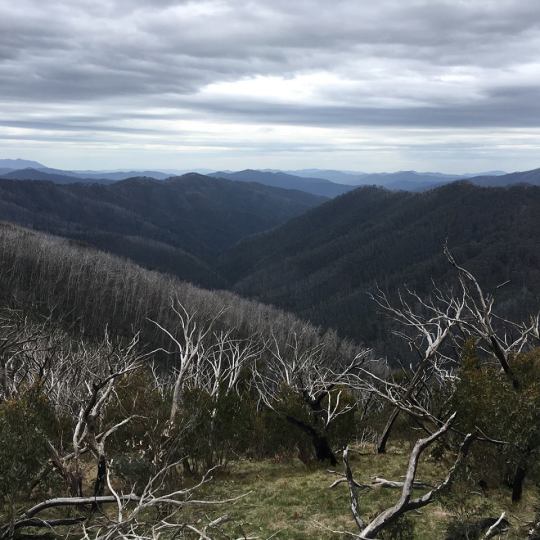
This was also the only time we’ve been at significant altitude in Australia. This meant snow (moderately exciting) but also high winds, which meant getting out even briefly at the viewpoints was somewhat unpleasant.

Since it was not actively raining when we reached the top, we decided to go on a walk from the weirdly named town of Dinner Plain. The walk was also fairly weirdly named; A Room with A View. The first thing we viewed was an enormous black snake, that was waiting patiently to cross the path in front of us. This was a bit surprising as there were patches of snow still around in the mountains and my limited understanding of snake biology is that they don’t like the cold. This one seemed pretty happy though. We think it was a red-bellied black snake, which is venomous, but only in a probably lifetime of miserable health complications after an ITU stay, rather than an instant death way like most Australian snakes.
The path was also really badly signed so we were quite pleased to find the eventual view point. The views were pretty good and from there we realised that we had done the circular walk the wrong way (there were actually arrows on trees but you could only see them from the other side). Did make it easier to find our way back though.
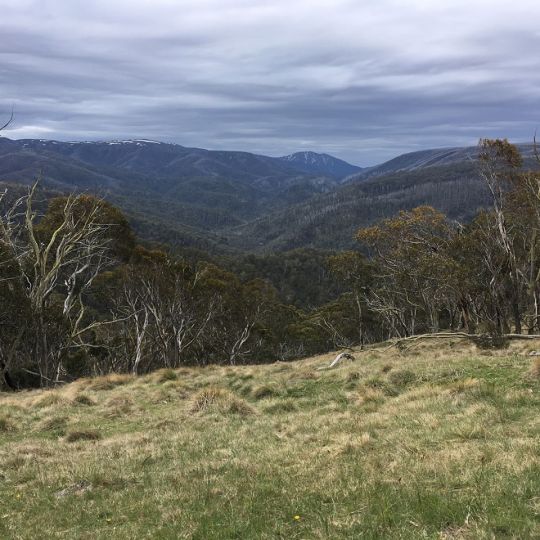
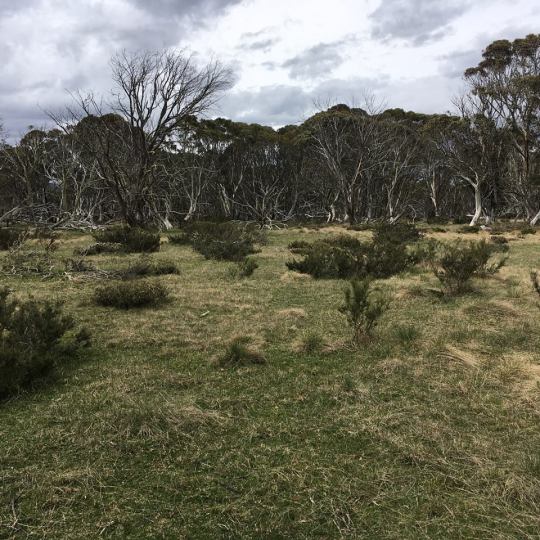
Our Airbnb had a tin roof and Marcel casually commented it would be nice to have heavy rain because he liked the sound of it. He probably regretted that statement, and I definitely did, when it teemed with rain overnight. The sound on the sloping tin roof, a few feet above our head, was not dissimilar I imagine to being stuck inside a coffee grinder. Not much sleep was had.
Alpine National Park is continuous with Kosciuszko National Park, which is just over the border in New South Wales. We had booked a night there, so headed out into the relentless rain the next morning.
Now Marcel was feeling rather guilty still about his corvid murder of the week before, and saw an opportunity to redeem himself. The rain had brought out a number of eastern long-necked turtles into the road, and every time we saw one Marcel would stop the car, turn around, drive back, get out in the pouring rain and move the turtle. He was feeling pretty good about this...until he drove over a magpie that decided to pay zero attention to the oncoming car.
I have always been keen on visiting the Snowy Mountains as they are home of the silver brumby in the Silver Brumby books I loved in my childhood. Unfortunately so thick was the mist and the heavy rain that we didn’t see much of it.


Weirdly though when we descended into our town for the night, East Jindabyne, the sun appeared. We decided to try a little walk in a low area of the park called Sawpit Creek.
It was beautifully sunny and there were lots of adorable wallabies around.
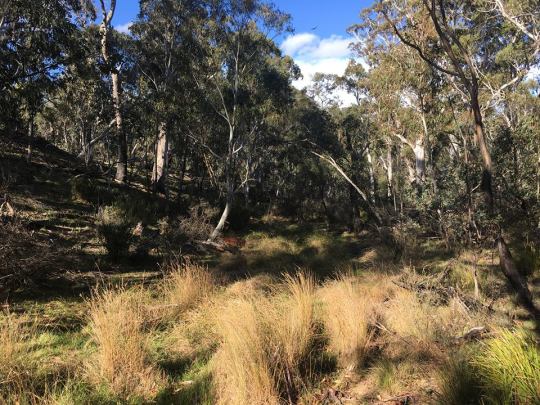


Feeling optimistic about the weather we decided to head back into the park...only to find if we went even a small distance up in altitude, the thick clouds and rain began again.
We abandoned it and headed to our airbnb for the night. A proper storm came on so we could watch lightening across the lake. That and the sad face of the random cat that appeared by our screen door. Now I know cats in Australia are terrible invasive predators...but this one was super cute. So we let it inside and fed it cheese.
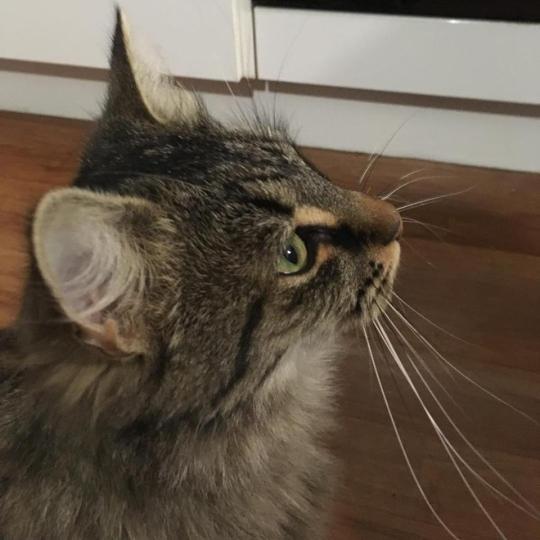
The next day we had hoped the weather would be better locally so we could explore the mountains. It was not. Never mind we thought, we are driving to the coast where there are some beautiful beaches, the weather must be better there so we will just enjoy them for the day. The forecast for there was also teeming rain.
So in utter desperation for something to do to fill the rainy day...we headed for Canberra. Now Canberra is not the world’s most exciting capital. The National Museum there is pretty decent though. We ignored the opportunity to pay to see the visiting exhibit featuring “treasures of the British Museum” and instead went to the free galleries. Which whilst not particularly cohesive on the history of Australia featured cool things like a mummified Tasmanian Tiger head, a collection of glass eyes and spear heads made from wine bottles. It passed the afternoon well.
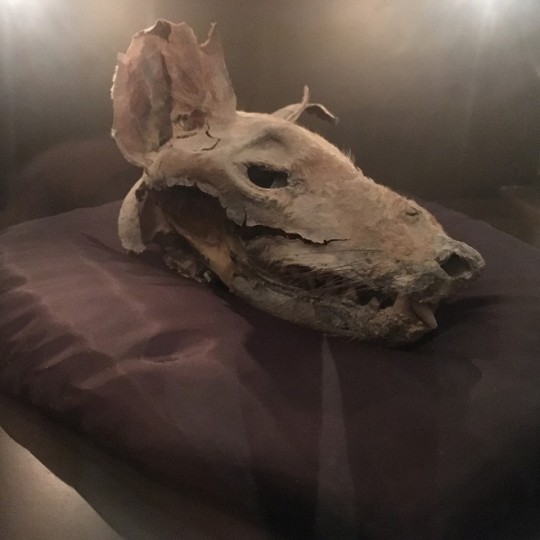
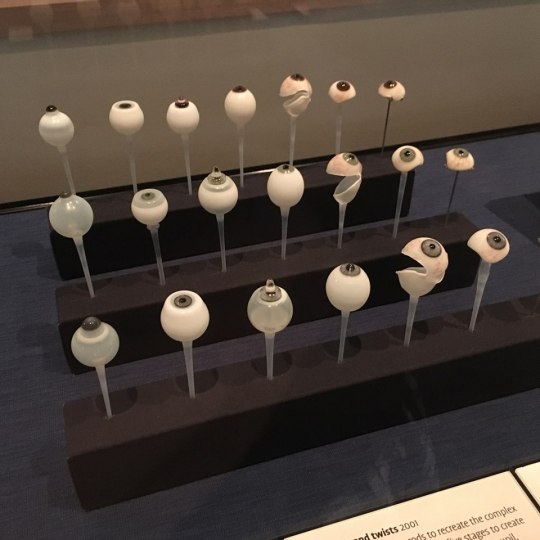
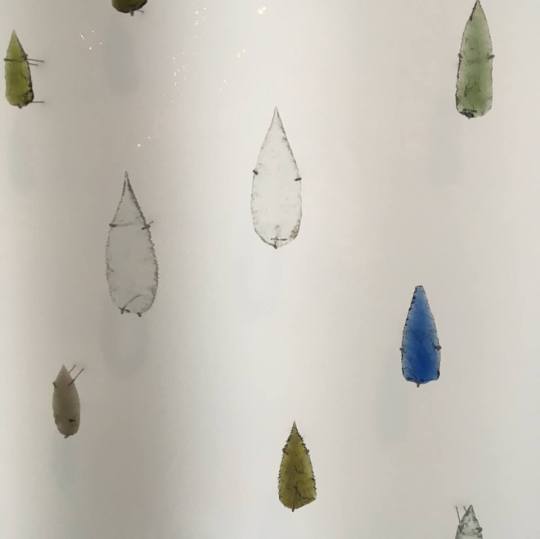
Fortunately the next day dawned gorgeous. After a week of pretty much solid rain it was blue skies and sunshine all around. Unfortunately we only had one hour to look at the best of the local beaches in Jervis Bay (we picked Hyams) before we had to head to Sydney.
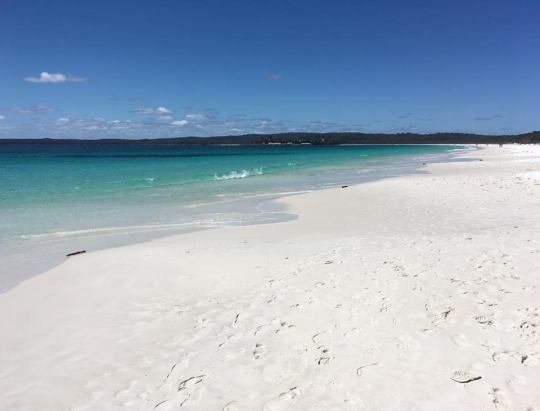
After a run in with an annoying question talking parking warden, we finally made our way to Esther’s flat, dumped what must have been an alarming amount of stuff at hers and dropped our filthy car back at the airport (sorry Hertz).
We then headed back into town. Earlier in the day I’d been talking with Marcel about how Australia was fine for a visit but I didn’t like the population’s right-leaning stance and casual racism. He said he didn’t think they were that racist. As we walked by the harbour bridge through the botanical gardens, we found ourselves calling the police as a man screamed racist abuse at non-white tourists, spat in their faces and hit one of them. No joy there in being right. Also the police were extremely tardy on bothering to turn up despite the fact that area of town must have had a lot. Despite this we enjoyed a lovely dinner with Esther before heading back out to the airport for a night in an airport hotel.
The reasoning for this was that whilst we were in this part of the world we might as well “pop” to New Zealand. It is a 3 hour flight from Sydney to Auckland, but that is a lot fewer hours than it is from London and it is a lot cheaper.
So on Friday we headed off to New Zealand. After the customary lengthily grilling at the flight counter about onward flights (really tempted to ask how often people, with hand luggage only, who are citizens of a rainy island with so-so social benefits, illegally emigrate to other rainy islands with so-so social benefits) we headed off.
We arrived to find… it starting to rain. Luckily it held off for a bit that evening so that we could go to a night market and stuff ourselves full of weird food including bubble waffles with our hosts Anita and Pete.

The next morning it woke up...beautifully sunny. Which was unsettling as this is NZ and it likes to rain on us in NZ. I did however remember that New Zealand sun= basically like shoving your body into fire and slathered myself with factor 50 before heading out. We meandered in the warm sun down to a market for breakfast, on to a chapel on top of a hill (never realised before how hilly Auckland is. Too hilly is my brief conclusion) and then after meeting up with Kate, we wandered slowly along the sea front, stopping for drinks, before we got to a Breton galette place about 10km down the shore.
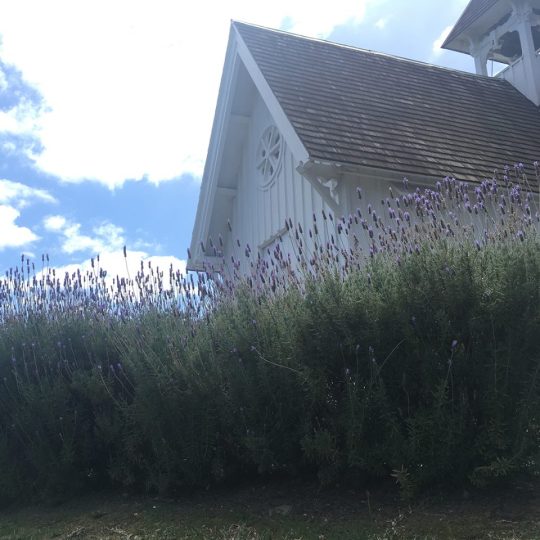
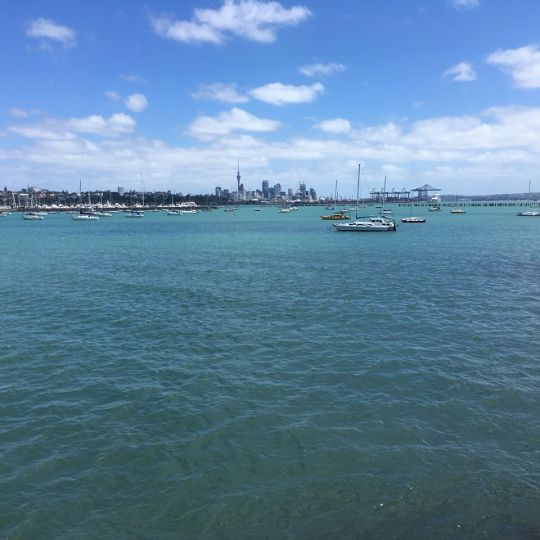

After stuffing ourselves, we waddled slowly back home. To find that no matter how thickly you slather on the suncream, NZ sun finds some way to chargrill you, and my forehead and patches around my neckline were pretty much maroon.
The next day we’d planned to go to a place called Piha beach. The weather forecast suggest it would be cloudy but wouldn’t rain there until the mid-afternoon. We had brunch. The sky gloomed ominously. We headed to the beach. It started to spit cold rain into our faces pretty much the second we arrived. I would have thought this was our standard NZ curse, but this was the second time the exact same thing had happened to Anita, so I think she was our Jonah of that trip.

When we got back to Auckland, Marcel and I decided to head over to Devonport, a little village suburb of Auckland that you can get to by ferry. We confirmed our suspicions that Anita was definitely the jinxed one when we enjoyed lovely sunshine all afternoon whilst a dark cloud glowered over Auckland.
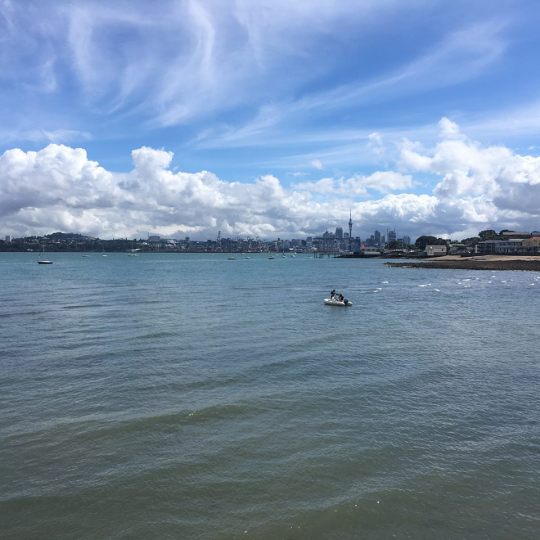
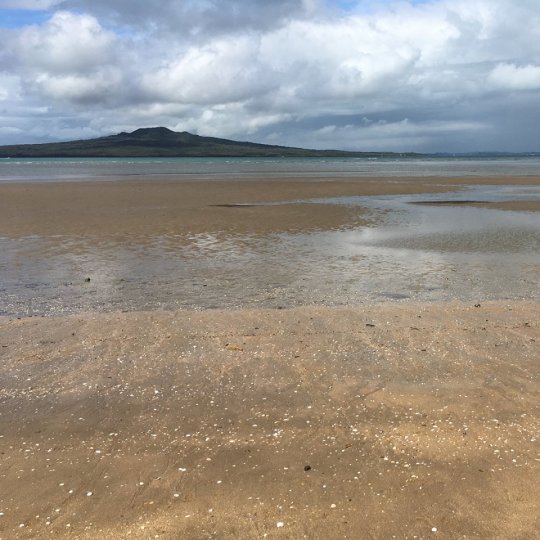
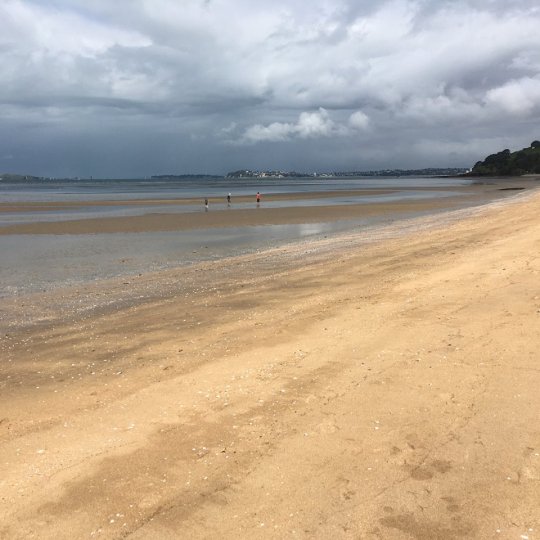
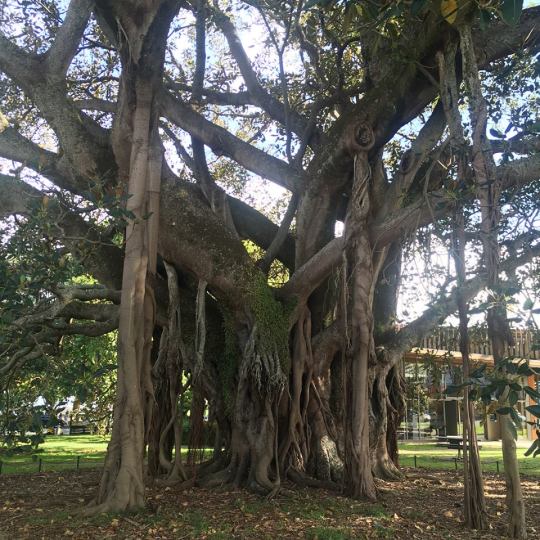

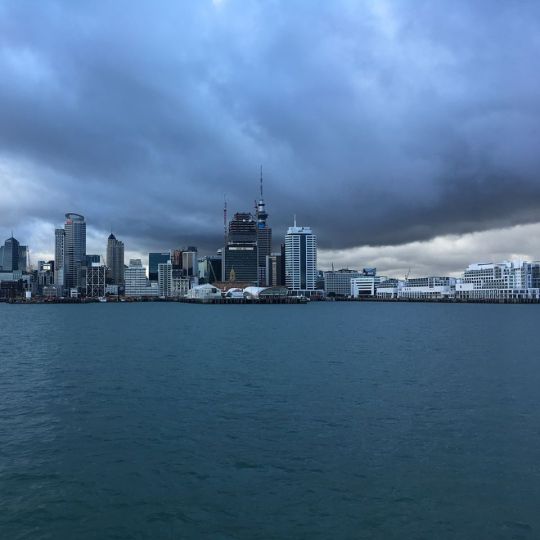
In the evening, reunited, we headed out for Mexican, and then to an ice cream store called Giapo that did weird flavours. Now I thought you’d just go in and order your weird ice cream. But no. Instead you are admitted in your pair/group/alone to stand around a small table, whilst a server brings out a selection of their favourite ice creams for you to try and discusses each one. I imagine it similar to being at a wine tasting, only more socially awkward as none of us were expecting it and weren’t really sure how to praise ice cream in an appropriate manner. I did ended up going for one of the ones our server had introduced but I hadn’t thought of, guacemole with strawberries. The ice cream was delicious. The corn nacho crumb that it was coated in I was less keen on.

We ended up finishing the night (and the week) watching The Meg, a gloriously terrible Jason Statham shark movie, whilst all shouting at the screen. Hilarious fun and reminded me of long-ago weekends down in Dorset.
Ways I thought I might die in Australia this week: fairly minimal as the rain prevented us leaving the car much. Perhaps just an apoplexy of wrath from the rain refusing to shut up as it banged down on our tin roof earlier this week. Oh and falling off a steep mountain pass in our car. And getting bitten by a surprisingly cold-tolerant snake.
0 notes
Text
How to Hire Canberra Roofing Services
Installing a new roof or Roof Repairs Canberra your existing roof are two very important tasks that you do not want to entrust to just anyone. You need to find a good roofing service to make sure that this crucial part of your homes' infrastructure is in good hands. There are a few things that you should investigate before you hiring a Canberra Roofing service company.
First, you want to find a service that specializes in roof works rather than just a general contractor that does some roofing jobs. A true roof company will have the expertise to help you design and select the materials for your roof in order to have the most energy efficient and long lasting roof possible.
Second, check to make sure that the service company has insurance and is bonded. You want to make sure that the work you pay for gets done to your satisfaction and in accordance with the contract that was signed by both parties and that is why a bond is needed. Liability and worker's compensation insurance are also necessary to protect the rest of your assets from possible damages and also to make sure that you cannot be personally held liable if someone were to get injured in the process of doing your roofing job.
Next, it is important to get good references. Many roofing companies can come up with a good estimate, but you want to make sure that their estimates are accurate and that they get the work done in the amount of time they indicate in their proposal. Also, you want to make sure that there were no problems with how the guys who work for the roofing service interact with the family members in the home. You can find out all this information by contacting people who have used their services in the past.
Finally, you want to try to find a roofing service company that offers other services for the home as well. In addition to yearly roof maintenance, it is also important to do yearly gutter cleaning, siding power washing, deck cleaning, etc. Many roofing companies have diversified their offerings in order to satisfy more of their customer's needs. People are more likely to bring you back for roof maintenance if they can also get their siding and gutters washed and cleaned.
Roof Works Roof Restoration is a Canberra based top quality roofing company dealing with all kinds of Roof Works Canberra. Visit their website @https://www.roofworksroofrestoration.com.au/ for more information.
#Roof Restoration Canberra#Roof Painting Canberra#Roof Coatings Canberra#Roof Repairs Canberra#Tile Restoration Canberra#Roof Cleaning Canberra#Exterior Painting Canberra#High Pressure Cleaning Canberra
0 notes
Text
Revitalize Your Home The Ultimate Guide To Roof Restoration In Canberra

Introduction: roofrestorationcanberra is a vital aspect of maintaining your home's structural integrity and aesthetic appeal. In Canberra's dynamic climate, where extreme weather conditions are common, ensuring your roof is in top condition is essential. Whether it's the scorching heat of summer or the heavy rains of winter, your roof withstands it all, protecting your family and possessions. In this comprehensive guide, we'll delve into the importance of roof restoration in Canberra, the common issues faced by homeowners, the restoration process, and the benefits it brings to your home and wallet.
Importance of Roof Restoration in Canberra: Canberra experiences a variety of weather conditions throughout the year, from blistering heatwaves to freezing temperatures and heavy rainfall. Such diverse weather patterns can wreak havoc on your roof, leading to a myriad of issues like leaks, cracks, and deterioration of materials. Roof restoration plays a crucial role in addressing these issues before they escalate into more significant problems, ultimately saving you time, money, and stress in the long run.
Common Roofing Problems in Canberra:
Leaks: One of the most common issues faced by homeowners in Canberra is roof leaks. These can occur due to damaged or missing shingles, cracked flashing, or improperly sealed joints.
Weather Damage: The harsh Australian sun can cause roofing materials to deteriorate over time, leading to cracks, warping, and fading. Additionally, heavy rains and strong winds can dislodge shingles and expose the underlying structure to water damage.
Moss and Algae Growth: Canberra's relatively humid climate provides the perfect breeding ground for moss, algae, and other organic growth on roofs. Not only does this detract from your home's curb appeal, but it can also cause damage to roofing materials if left untreated.
Poor Ventilation: Inadequate ventilation can lead to moisture buildup in the attic, resulting in mold growth, wood rot, and decreased energy efficiency.
Structural Damage: Over time, the structural integrity of your roof may be compromised due to age, wear and tear, or improper installation.
The Restoration Process:
Inspection: A thorough inspection of your roof is conducted to identify any existing issues or potential problems.
Cleaning: The roof is cleaned to remove dirt, debris, moss, algae, and other contaminants that may compromise the restoration process.
Repairs: Any damaged or deteriorated roofing materials are repaired or replaced to ensure the structural integrity of the roof.
Rejuvenation: The roof is treated with specialized coatings or sealants to enhance its durability, weather resistance, and appearance.
Maintenance: Regular maintenance is essential to prolong the lifespan of your roof and prevent future problems.
Benefits of Roof Restoration:
Enhanced Curb Appeal: A freshly restored roof can significantly improve the overall appearance of your home, increasing its value and attractiveness to potential buyers.
Increased Lifespan: By addressing existing issues and applying protective coatings, roof restoration can extend the lifespan of your roof by several years.
Energy Efficiency: Properly restored roofs are more energy-efficient, helping to regulate indoor temperatures and reduce heating and cooling costs.
Cost Savings: Investing in roof restoration can save you money in the long run by preventing the need for costly repairs or premature replacement.
Peace of Mind: Knowing that your roof is in top condition provides peace of mind, allowing you to enjoy your home without worrying about leaks or structural damage.
Conclusion: In conclusion, roof restoration is a critical aspect of maintaining your home's integrity and value, especially in a dynamic climate like Canberra. By addressing common roofing issues, such as leaks, weather damage, and organic growth, you can prolong the lifespan of your roof, enhance its appearance, and save money on costly repairs. Whether you're looking to improve your home's curb appeal or protect it from the elements, investing in roof restoration is a decision you won't regret. So, revitalize your home today and enjoy the benefits of a healthy, functional roof for years to come.
0 notes